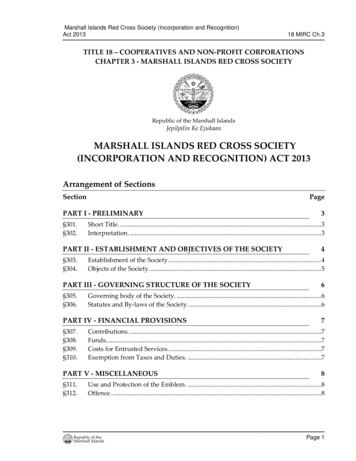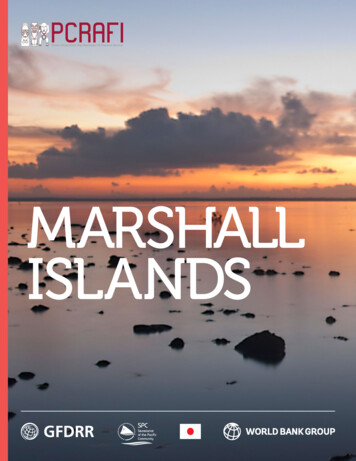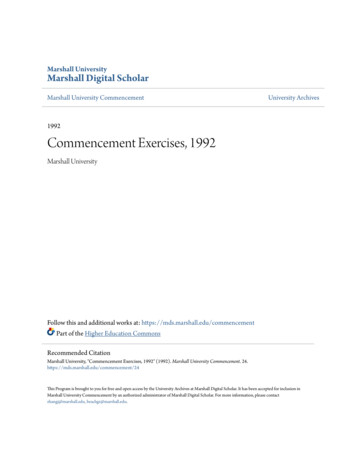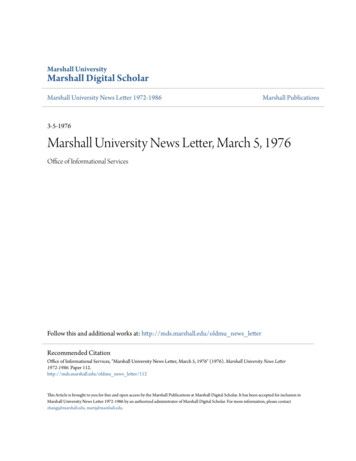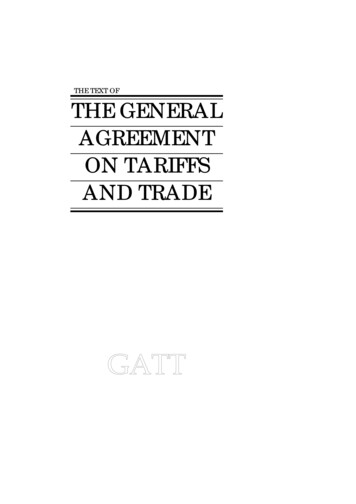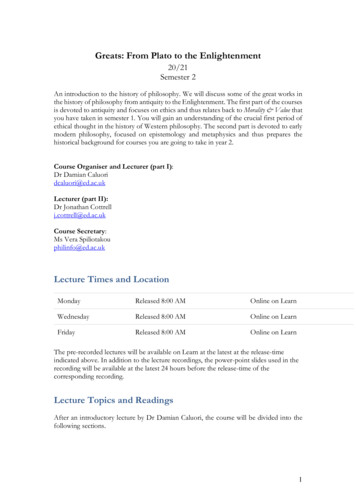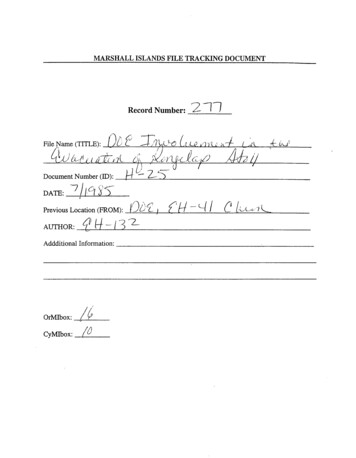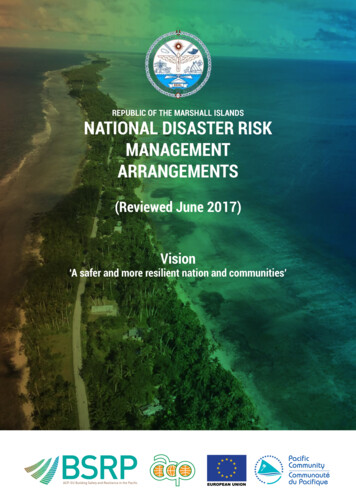
Transcription
NATIONAL DISASTER RISK MANAGEMENT ARRANGEMENTS - (Reviewed June 2017)REPUBLIC OF THE MARSHALL ISLANDSNATIONAL DISASTER RISKMANAGEMENTARRANGEMENTS(Reviewed June 2017)Vision‘A safer and more resilient nation and communities’
NATIONAL DISASTER RISK MANAGEMENT ARRANGEMENTS - (Reviewed June 2017)2
NATIONAL DISASTER RISK MANAGEMENT ARRANGEMENTS - (Reviewed June 2017)REPUBLIC OF THE MARSHALL ISLANDSNATIONAL DISASTER RISKMANAGEMENTARRANGEMENTS(Reviewed June 2017)3
NATIONAL DISASTER RISK MANAGEMENT ARRANGEMENTS - (Reviewed June 2017)TABLE OF CONTENTSAcronyms 10Part 11.11.21.31.41.51.61.71.8General11Background 12Executive Summary 13Authorities and ReferencesImplementation of the Arrangements 14Country ProfileNational Hazard Profile15National Risk Profile16Supporting Plans for the NDRMAPart 2 The National Disaster Risk Management Arrangements172.1NDRMA Aims and Objectives 182.2Risk Management in the context of Disaster Risk Management2.3Risk Management In the context of Development Planning192.4NDRMA Relationship with SubsidiaryPlans2.5Description and Scope of Subsidiary Plans202.6Illustrated Relationship of Subsidiary Plans212.7Relationship of Acts, Regulations and Policy, and Regional/GlobalArrangements with the NDRMA2.8Disaster Risk Management in the Pacific Region222.9Guiding Principles for Disaster Risk Management2.10Monitoring and Review of the NDRMA232.11Governance Structure and Authroity to vary or amend the NDRMA24Part 3 Disaster Risk Management 253.1General 263.2Disaster Risk Management3.3Disaster Risk Management Model 283.4Climate Change Mitigation & Adaptation 293.5Key Elements of the DRM Model 303.6Institutional Framework for DRM3.7DRM Governance 313.8Roles and Responsibilities 323.8.1 The Responsible Minister3.8.2 Office of The Chief Secretary3.8.3 National Disaster Committee3.8.4 Membership of the NDC 333.8.5 NDC Advisory Groups 343.8.6 National Disaster Management Office3.8.7 Office of Environmental Planning and Policy Coordination353.8.8 Local Government Disaster Risk Management Arrangements3.9Government Partners 373.9.1 Non Government Organisations3.9.2 Women United Together for the Marshall islands3.9.3 Churches3.9.4 Marshall Islands Red Cross Society383.9.5 Private SectorPart 4 - Disaster Risk Reduction 394.14.24.34.44.54.6General 40Prevention 41Mitigation 42AdaptationRisk Management 43Risk Advidsory Group4
NATIONAL DISASTER RISK MANAGEMENT ARRANGEMENTS - (Reviewed June 2017)Part 5 - Disaster Management 455.15.25.35.45.55.65.75.85.9Disaster Management –General 46Disaster Preparedness 47Emergency Communications 48Disaster Risk Management Training5.4.1 Training Advisory Group5.4.2 Procedural Guidelines 49Exercises and Drills 50Education and Community Awareness 51Department and Agency Preparedness & Response Plans525.7.1 Standard Operating Procedures5.7.2 Business Continuity Plan 53Warning and Alerting Systems 54Safety Shelters 56Part 6 - Disaster Response .156.166.17Disaster Response – General 586.1.1 Levels of Response 596.1.2 Conditions of responseNational DRM Structure in Emergencies/Disasters596.2.1 Institutional Arrangements for National Emergencies/Disasters60Lead and Support Agencies for Specific Events61Response Support Agencies 62National Emergency Operations Centre 636.5.1 NEOC Management StructureNational Disaster Coordinator 64Declaration of State of EmergencyDeclaration of State of Disaster 65National Leadership6.9.1 National Clusters6.9.2 National Clusters Core Functions 66Outer Island/Atoll DRM Response ArrangementsRequests for Internationasl Assistance 676.11.1 Institutional Arrangements when International Assistance RequestedThe Pacific Humanitarian Cluster Coordination Mechanism68Initial Damage Assessments 69Post Disaster needs AssessmentMedia Broadcasts 70Post Disaster Debriefs 71Post Disaster Response Review 72Part 7 – Relief 737.17.27.37.47.5Disaster Relief 74Regional Guidelines for International Disaster Assistance and75Cooperation in the PacificContinuity of Relief EffortsCustoms and QuarantineFinancial Considerations 76Part 8 – Recovery 778.18.28.3Disaster Recovery 78Early RecoveryNational Recovery Committee 795
NATIONAL DISASTER RISK MANAGEMENT ARRANGEMENTS - (Reviewed June 2017)FOREWORDThe recent droughts that have impacted the Republic of the Marshall Islands haveprovided the ideal opportunity to undertake a review of the National Disaster RiskManagement Arrangements. Many lessons have been learned which are incorporatedwithin these revised Arrangements. The task ahead is to implement those parts ofthese Arrangements which will enhance future levels of preparedness and response toany emergency or disaster.The resources directed to this review reflect the commitment of government to thestrengthening of policies and supporting plans for the mitigation and management ofdisasters. Protection of lives, property and our livelihoods is a national priority. The reviewwill strengthen existing institutional arrangements and governance, and ensure that inthe event of a disaster overwhelming national resources, international humanitarianassistance can be accommodated within national coordination arrangements insupport of the national response.The success of these arrangements will depend on the commitment of those withauthorised responsibilities to effectively carry out their designated roles and tasks. It willalso require a cooperative, coordinated and collaborative approach by all stakeholdersto ensure an integrated, whole of government and whole of country approach thatreduces the impact of underlying social, economic and environmental risks to nationaldevelopment and strengthens the preparedness and resilience of our nation andcommunities to the adverse effects of emergencies and disasters.President6
NATIONAL DISASTER RISK MANAGEMENT ARRANGEMENTS - (Reviewed June 2017)GLOSSARY OF TERMSClimate Change Adaptation: The reduction of vulnerability to the increasing risks ofclimate change and climate variability through adaptation processes and strengtheninghuman and institutional capacities to assess, plan and respond to the challenges.Command: the direction of members and resources of an organization in the performanceof its agreed roles and tasks. The authority to command is established in legislation orby agreement within an organization.Control: The direction of emergency management activities in a designated emergencysituation. The authority for control is established in legislation or in an emergency(or disaster) plan, and carries with it responsibility for tasking and coordinating otherorganizations in accordance with the needs of the situation.Contingency Planning: The process of describing roles/responsibilities andarrangements for the performance of key response functions specific to a designatedmajor threat (e.g. tsunamis, droughts, major fires, hazardous materials incidents,airport/port emergencies, animal/plant disease, marine pollution, etc.).Coordination: The bringing together of organisations to ensure effective emergencymanagement response and recovery, with primary concern for systematic acquisitionand application of resources (people, material, equipment, etc.) in accordance withrequirements imposed by the threat or impact of an emergency or disaster.Disaster: A serious disruption of the functioning of a community or a society,causing wide spread human, material, economic or environmental losses whichexceed the ability of the affected community or society to cope using its ownresources. A disaster is a function of the risk process. It results from the combinationof hazards, conditions of vulnerability and insufficient capacity or measuresto reduce the potential negative consequences of risk.Disaster Management (also known as Emergency Management): the organisationand management of resources and responsibilities for dealing with all aspects ofemergencies/disasters, particularly preparedness, response, relief and recovery.Disaster Risk Management: The performance of all forms of activities, includingstructural and non-structural measures, to avoid (prevention) or to limit (mitigation andpreparedness) risks and lessen the impacts of natural, man-made, environmental andtechnological disasters.Disaster RiskReduction: The concept and practice of reducing disaster risks throughsystematic efforts to analyse and manage the causal factors of disasters, includingthrough reduced exposure to hazards, lessened vulnerability of people and property,wise management of land and the environment, and improved preparedness for adverseevents.Early WarningSystems: The set of capacities needed to generate and disseminatetimely and meaningful warning information to enable individuals, communities andorganizations threatened by a hazard to prepare and to act appropriately and insufficient time to reduce the possibility of harm or loss.Emergency:An event that requires a multi-agency response. The management ofan emergency requires a well-coordinated approach but can be managed with theresources that are available.Hazard: A dangerous phenomenon, substance, human activity or condition that maycause loss of life, injury or other health impacts, property damage, loss of livelihoodsand services, social and economic disruption, or environmental damage.7
NATIONAL DISASTER RISK MANAGEMENT ARRANGEMENTS - (Reviewed June 2017)Hazard Mitigation: Measures designed to reduce vulnerability by preventing or reducingthe adverse impacts of hazards. Mitigation is wide ranging and covers communitybased risks as well as underlying risks to national development. It operates within thebroad context of sustainable development.Incident: A routine event that is responded to by a single agency or a small numberof agencies. A routine event may not need much resources and coordination at theincident scene.Lead Response Agency: An agency designated as primarily responsible for themanagement of a specific function or for the control role in a specified type of event.Mitigation: The lessening or limitation of the adverse impacts of hazards and relateddisasters.National Emergency Operations Center: A facility from which the control of nationalemergency or disaster operations and coordination of resources are carried out.Preparedness: The knowledge and capacities developed by governments, professionalresponse and recovery organizations, communities and individuals to effectivelyanticipate, respond to, and recover from, the impacts of likely, imminent or currenthazard events or conditions.Prevention: The regulatory and physical measures to ensure that disasters areprevented, or their effects mitigated. While it is not possible to prevent all risks, thereare many examples of activities such as health-related and fire prevention educationprograms that can eliminate risks.Recovery:The restoration, and improvement where appropriate, of facilities, livelihoodsand living conditions of disaster-affected communities, including efforts to reducedisaster risk factors.8
NATIONAL DISASTER RISK MANAGEMENT ARRANGEMENTS - (Reviewed June 2017)Relief: The coordinated process of providing humanitarian relief and basic communitysupport services during and immediately after the impact of a disaster.Resilience:The ability of a system, community or society exposed to hazards to resist,absorb, accommodate to and recover from the effects of a hazard in a timely andefficient manner, including through the preservation and restoration of its essentialbasic structures and functions.Response: The actions taken in anticipation of, during, and immediately after, anemergency or disaster to ensure that its effects are minimized and that people affectedare given immediate relief and support.Risk: The probability of an event and its negative consequencesRisk Assessment: A methodology to determine the nature and extent of risk by analysingpotential hazards and evaluating existing conditions of vulnerability that together couldpotentially harm exposed people, property, services, livelihoods and the environment onwhich they depend.Risk Management: The systematic approach and practice of managing uncertainty tominimize potential harm and loss.Standard Operating Procedures:The prescribed routine action to be followed by staffduring emergency operations.Support Response Agency: An agency designated in a plan as undertaking a supportrole to the lead agency in relation to a specific function or in a specified type of event.Sustainable development: Development that meets the needs of the present withoutcompromising the ability of future generations to meet their own needs.Vulnerability: The characteristics and circumstances of a community, system or assetthat make it susceptible to the damaging effects of a hazard.9
NATIONAL DISASTER RISK MANAGEMENT ARRANGEMENTS - (Reviewed June 2017)ACRONYMSBCPBusiness Continuity PlanCSS&OIAMinistry of Culture, Social Services and Outer Island AffairsDM Disaster ManagementDRMDisaster Risk ManagementDRRDisaster Risk ReductionEPAEnvironmental Protection AuthorityEPPSOEconomic Policy, Planning and Statistics OfficeESTMinistry of Education, Sports and TrainingEWSEarly Warning SystemFACTMinistry of Fisheries, Agriculture, Commerce and TourismFATMinistry of Foreign Affairs and TradeFBPSMinistry of Finance, Banking and Postal ServicesHHSMinistry of Health and Human ServicesIDAInitial Damage AssessmentIOMInternational Organisation for MigrationIFRCInternational Federation of Red Cross and RedCrescentSocietiesJILMinistry of Justice, Immigration and LabourJNAPJoint National Action PlanMoUMemorandum of UnderstandingNDCNational Disaster CommitteeNDMONational Disaster Management OfficeNEOCNational Emergency Operations CentreNGONon-Governmental OrganizationNSPNational Strategic PlanOEPPCOffice for Environmental Planning and Policy CoordinationPDNAPost Disaster Needs AssessmentSOPStandard Operating ProceduresTC&ITMinistry of Transportation and Communication and InformationTechnologyUNOCHAUnited Nations Office forthe Coordination of HumanitarianAffairsUNISDRUnited Nations Office for Disaster Risk ReductionWIUMinistry of Works, Infrastructure and Utilities10
NATIONAL DISASTER RISK MANAGEMENT ARRANGEMENTS - (Reviewed June 2017)Part e SummaryAuthorities and ReferencesImplementation of the ArrangementsCountry ProfileCountry Hazard ProfileCountry Risk ProfileSupporting Plans for the NDRMA11
NATIONAL DISASTER RISK MANAGEMENT ARRANGEMENTS - (Reviewed June 2017)1.1 BackgroundThis revised version of the NDRMA builds upon the objectives of the 2012 NationalDisaster Risk Management Arrangements.The Review incorporates the RMI experiences from 2013 & 2016 droughts and is mindfulof the 2013 National Progress Report on the implementation of the Hyogo Frameworkfor Action. Those Authorities and References which assisted in this review are listedin Section 1.7. and in particular those parts relating to International HumanitarianResponse Arrangements. Finally it establishes a platform to further assist in theimplementation of the JNAP, the Sendai Framework for Disaster Risk Reduction, andthe Framework for Resilient Development in the Pacific.The NDRMA is presented in 6 Parts:Part 1Part 2Part 3Part 4Part 5Part 6Part 7Part 8GeneralThe structure and context explains the ‘setting’ in which the Arrangementsare developed; the country profile, the hazards to which RMI is vulnerable;the manner in which risks will be analysedThe NDRM ArrangementsDescribes the aims, objectives and principles; It outlines disaster riskmanagement in the context of planning and development detailing the riskmanagement concept in disaster risk management. It includes guidingprinciples behind the Arrangements and the future monitoring by which theNDRMA will be maintained as a ‘living document’.Disaster Risk ManagementDescribes the DRM model and its components. It outlines institutionalarrangements and governance structuresDisaster Risk ReductionDescribes prevention, adaptation and mitigation strategies in the context ofboth DRM and CCDisaster ManagementFocuses on Disaster Preparedness. This includes training and exercisemanagement, the development of supporting plans, communicationsincluding warning and alert mechanisms and provides direction on keyactivities including the arrangements for requesting and coordinatingInternational Humanitarian AssistanceDisaster ResponseFocuses on Disaster Response. It includes institutional arrangementsfor disaster including those times when international humanitarianassistance is requested. It addresses roles and responsibilities for responseagencies, incident management system and described the national clusterarrangementsDisaster ReliefFocuses on Disaster Relief. This part introduces the Regional Guidelines forInternational Disaster Assistance and Cooperation in the Pacific designedto provide a legal framework for international assistance. It also includesdisaster financing and the mechanisms associated with the release offunding.Disaster RecoveryFocuses on Disaster Recovery. It outlines the aims of early recovery, theroles and responsibilities for coordination and the functions of the RecoveryCommittee.12
NATIONAL DISASTER RISK MANAGEMENT ARRANGEMENTS - (Reviewed June 2017)1.2 Executive SummaryThe review of the National Disaster Risk Management Arrangements (NDRMA) 2012(hereinafter referred to as ‘Arrangements’ or ‘NDRMA’) has been coordinated by theNational Disaster Management Office (NDMO) on behalf of the National DisasterCommittee (NDC). The existing Arrangements were last reviewed in 2012. Since thattime the Republic of the Marshall Islands has been impacted by two major droughtsin 2013 & 2016, and has also seen the development of the Joint National Action Planfor Climate Change and Disaster Risk Management 2014-2018. There is recognitionthat greater clarity is required around both the roles and responsibilities for nationalclusters and the international humanitarian assistance arrangements. Furthermore, theCompact as Amended grants which expires in 2023 must be viewed within the contextof this review to ensure the coordination of national DRM initiatives, currently sharedby in-country partners, are gradually migrated to and embedded within the NDMO keyresponsibilities, that of coordinating national DRM strategy and planning.The National Disaster Management Office will be responsible for coordinating theimplementation of the NDRMA through the NDRMA Implementation Plan. It is anticipatedthat this Plan can be rolled out over a period of three years.It is recognised that disaster risk reduction is critical to realise the aspirations of nationaleconomic growth and sustainable development and that success lies within developinga structured and consciously managed risk approach. The NDRMA will provide thestructure to enable the continuous identification, monitoring and assessment of currentas well as possible future hazards and vulnerabilities and manage associated risks in amanner to minimise their possible adverse consequences.An all hazards approach, by definition, includes those hazards related to climatechange. Actions to reduce vulnerability and increase resilience across the DRMspectrum, includes those actions designed to address climate change hazards. TheNDRMA creates an environment where all disaster risk is assessed collectively and maybe integrated in a policy, program and planning context.The NDRMA recognises the roles played by community, state, national, regional andinternational partners, and the need to be integrated within a coordination framework,ensuring personnel across all sectors have a clear understanding of their roles andresponsibilities within the system.1.3 Authorities and ReferencesThe documents that serve as authorities and references for the NDRMA include thefollowing;»Disaster Assistance Act 1987»The Emergencies Act 1979»Joint National Action Plan 2014-2018. Incorporating the; National Climate Change Policy Framework 2010»National Strategic Plan 2015-2017»National Action Plan for Disaster Risk Management 2008-2018»National Disaster Management Arrangements 2012»The Post Disaster Needs Assessment 201613
NATIONAL DISASTER RISK MANAGEMENT ARRANGEMENTS - (Reviewed June 2017)»»»UNDP 2014 – Establishment of Institutional Mechanisms for Disaster RiskManagement in the RMIThe Sendai Framework. The successor instrument to the; Hyogo Framework for Action (HFA) 2005-2015: Building the Resilience ofNations and Communities to Disasters. Pacific Disaster Risk Reduction and Disaster Management Framework forAction2005–2015 (Madang Framework)Framework for Resilient Development in the Pacific 2016-20301.4 Implementation of the ArrangementsThe implementation of the 2016 NDRMA Review will be advised by the NDRMAImplementation Plan. This may occur over a period of 3 years following endoresmentof the review outcomes. During and after this period the currency and accuracy of theNDRMA will be maintained through the process of monitoring and review as outlined inSection 1.7.1.5 Country ProfileGeographically remote, the Marshall Islands is particularly vulnerable to both naturaland technological hazards. The Marshall Islands spread across 29 low-lying atollsand 5 islands covering a total land area of 70 square miles is set in 700,000 squaremiles of ocean. The distance between the capitol Majuro and furthest outlying atollis approximately 700 miles. It has a population of approximately 53,000 with over twothirds located in the main centers of Majuro and Kwajalein. The atolls and islands thatmake up the group lie in two parallel chains of atolls; Ratak, or Sunrise to the East;and Ralik or Sunset to the West. The two atoll chains are approximately 129 milesapart and are aligned diagonally northwest to southwest. This isolation combined withfragile ecosystems, and an economy reliant upon agriculture and fisheries, potentiallyincreases the consequences of emergency/disaster events.The government is a major employer, followed by the commercial and retail sectors. Theconstruction industry is expanding, but fisheries, copra, handicrafts and subsistenceagriculture form the larger part of the remaining limited domestic production. Howeverthe remoteness of the islands and the limited resources available to address the existingand emerging risks presents significant challenges.Risks to development in the Republic of the Marshall Islands emanate from both naturaland man-made hazards.The Republic of the Marshall Islands is exposed to a number ofnatural hazards including tropical storm, typhoon and drought.The remoteness of the islands and the limited resources available to address longestablished and emerging risks presents significant challenges to the Governmentin continuing to reduce the vulnerability of the communities throughout the Islands,including exposure to emerging global issues, in particular changing weather patterns.The ability to measure this vulnerability is increasingly seen as a key step towardseffective risk reduction and the promotion of a culture of disaster resilience. Theidentification of hazards is an established ‘starting point’ in identifying underlying14
NATIONAL DISASTER RISK MANAGEMENT ARRANGEMENTS - (Reviewed June 2017)vulnerabilities and reducing disaster risk, with the degree of risk being determined inthe knowledge of the physical, social, economic and environmental vulnerabilities towhich communities are exposed.Further contributing towards community vulnerability is the negative impacts of eventson development, and conversely, inappropriate development that creates vulnerabilities.It is within this complex environment which includes climate change, social disparity,struggling economies and the many other influences that determine vulnerability, thehazard profile plays a lead role in identifying causal factors.1.6 National Hazard ProfileThe national hazard profile contains both natural and man-made hazards. However,driven by human intervention, many activities change the characteristics of thesehazards whilst at the same time creating new hazards. Although climate change isa major driver in these changes other factors play increasing roles; industrialisation,urbanisation, changing population demographics and societal changes, are just someof these change agents. The result is a constantly shifting hazard profile.Natural and man-made risks and their accompanying vulnerabilities arise from thesehazard; the vulnerabilities are also shaped by economic and social factors alongsidethe capacity to deal with the risks. Hence, the national hazard profile as the source ofrisk needs to be accurately maintained to ensure it represents the hazard environmentand changes that may occur and is an essential part of the Disaster Risk Managementcycle.Due to potential changes to hazards, risks and vulnerabilities it is essential thatprocesses exist whereby risks arising from all hazards are effectively assessed andregularly monitored to inform disaster risk reduction and disaster managementinitiatives. It is proposed that hazard profile monitoring is conducted by a sub-committeeof the National Disaster Committee - the Risk Advisory Group. The establishment ofthis sub-committee its roles and responsibilities are contained within the NDRMAImplementation Plan.The following hazards have been identified in previous reviews as being those mostlikely to impact the Republic of the Marshall Islands. They have been rated in terms oftheir risk potential as either; high, medium or low. The following list of hazards and theirrisk rating will be reviewed under the Implementation Plan; in particular the method ofrating risk will be enhanced, introducing a transparent and auditable process to assistin cyclical reviewsNatural HazardsTropical storm and typhoonHigh surfDroughtVolcanoesTsunamiLevel of RiskHigh riskHigh riskMedium riskLow riskLow risk15
NATIONAL DISASTER RISK MANAGEMENT ARRANGEMENTS - (Reviewed June 2017)Human-induced and other HazardsFireMarine oil spillWater supply contaminationHazardous materialsEpidemic diseaseCommercial transport accidentLevel of RiskHigh riskHigh riskHigh riskHigh riskHigh riskMedium risk1.7 National Risk ProfileThe ability to identify and measure risks and associated vulnerabilities which arisefrom the national hazard profile is an essential step in reducing disaster risk.Inabilityto accurately identify and assess risks will contribute towards community vulnerabilityand the negative impacts of disaster events on development.Risk is the linking function across all hazards and a key tool in integrating climatechange within the DRM model. Risk management can be effectively integrated intoday to day planning and link into the annual strategic, business and budget planningprocesses.It is proposed that the development of a risk profile is conducted by a sub-committee ofthe National Disaster Committee - the Risk Advisory Group. The establishment of thissub-committee its roles and responsibilities are contained within Section 4.6.1.8 Supporting Plans for the NDRMAUnder the NDRMA there are requirements for supporting (or subsidiary) plans to bedeveloped at many levels. To ensure these plans are developed consistently anduse common terminology a guide on the development of these plans is included inSection 2.5 The role of the NDMO is to provide technical advice and guidance in thedevelopment of these plans and conduct an annual review to ensure that plan ‘owners’have undertaken an annual review for accuracy and currency in all aspects of the planand to advise of any exercise management ‘tests’ that have been conducted. Theseresults will be part of an annual report from the NDMO to the NDC.16
NATIONAL DISASTER RISK MANAGEMENT ARRANGEMENTS - (Reviewed June 2017)Part 2The Arrangements2.12.22.32.42.52.62.7NDRMA Aims and ObjectivesRisk Management in the context of Disaster Risk ManagementRisk Management in the context of Development PlanningNDRMA relationship with Subsidiary PlansDefinition and Scope of Subsiduary PlansIluustrated Relationship of Subsidiary PlansRelationship of Acts, Regulations and Policy, and Regional/Global Arrangements with the NDRMA2.8 Disaster Risk Management in the Pacific Region2.9 Guiding Principles for Disaster Risk Management2.10 Monitoring and Reviewing the NDRMA2.11 Governance Structure and Authority to vary or amend theNDRMA17
NATIONAL DISASTER RISK MANAGEMENT ARRANGEMENTS - (Reviewed June 2017)2.1 NDRMA Aims and ObjectivesThe aim of the Arrangements is to provide-:»A framework to encompass Disaster Risk Management in its entirety and toprovide guidance for decision makers in the development of associated riskreduction, emergency response and contingency plans and procedures by thosedepartments, sectors and agencies who have mandated responsibilities for suchactivities.»They also provide a guide to regional and international organizations who shouldconsider these national arrangements when developing any related regionalDRM projects and programmes including regional contingency plans to ensurethat they complement and support the national process.The objectives of the Arrangements are to-:»Establish a mechanism for effective control, coordination, decision making,accountability, and organisational arrangements for all aspects of disastermanagement.»Describe organisational arrangements that maximise the use of availableresources based on an all hazards approach.»Promote integrated planning and collaboration for disaster management anddisaster risk reduction across and within all levels of government, sectors andcommunities»Support the
3.9.4 Marshall Islands Red Cross Society 38 3.9.5 Private Sector Part 4 - Disaster rrisk eduction 39 4.1General 40 4.2Prevention 41 4.3Mitigation 42 4.4Adaptation 4.5Risk Management 43 4.6Risk Advidsory Group . 5 NATIONAL DISASTER RISK MANAGEMENT ARRANGEMENTS - (Reviewed June 2017) Part 5 - Disaster Management 45 .



